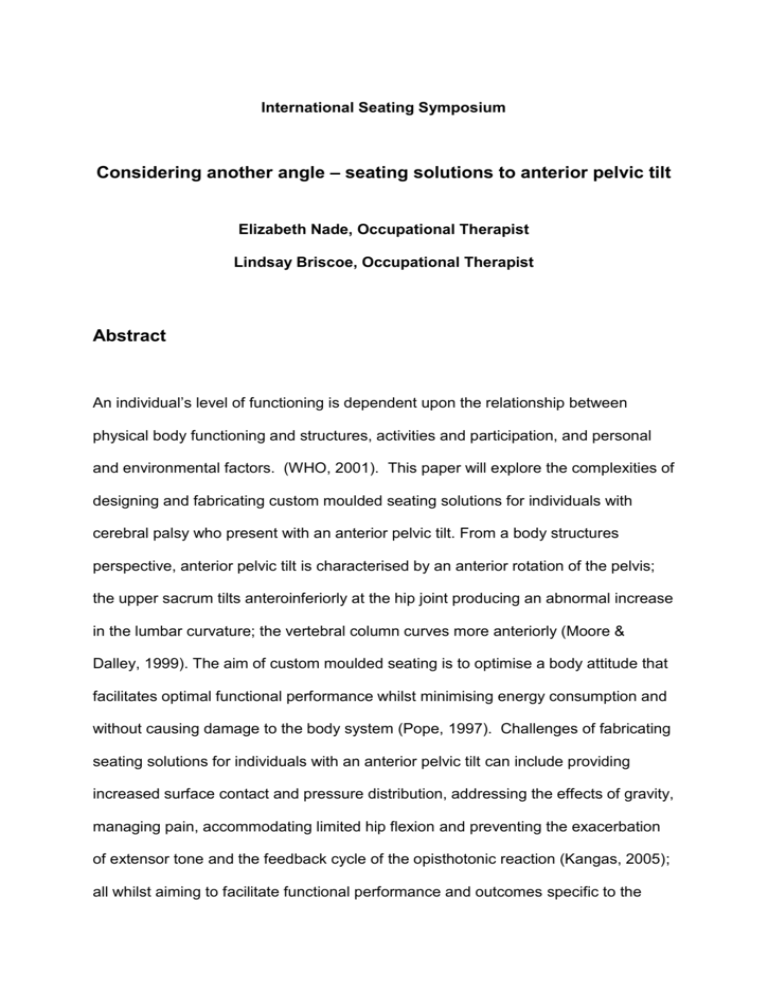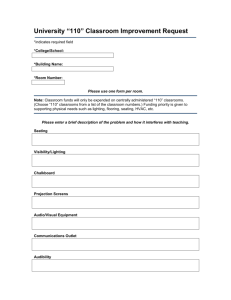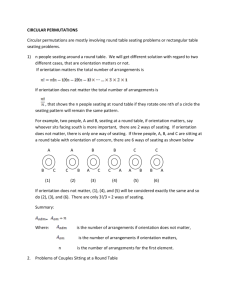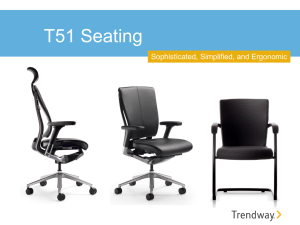NADE_Elizabeth_abstract_arata14
advertisement

International Seating Symposium Considering another angle – seating solutions to anterior pelvic tilt Elizabeth Nade, Occupational Therapist Lindsay Briscoe, Occupational Therapist Abstract An individual’s level of functioning is dependent upon the relationship between physical body functioning and structures, activities and participation, and personal and environmental factors. (WHO, 2001). This paper will explore the complexities of designing and fabricating custom moulded seating solutions for individuals with cerebral palsy who present with an anterior pelvic tilt. From a body structures perspective, anterior pelvic tilt is characterised by an anterior rotation of the pelvis; the upper sacrum tilts anteroinferiorly at the hip joint producing an abnormal increase in the lumbar curvature; the vertebral column curves more anteriorly (Moore & Dalley, 1999). The aim of custom moulded seating is to optimise a body attitude that facilitates optimal functional performance whilst minimising energy consumption and without causing damage to the body system (Pope, 1997). Challenges of fabricating seating solutions for individuals with an anterior pelvic tilt can include providing increased surface contact and pressure distribution, addressing the effects of gravity, managing pain, accommodating limited hip flexion and preventing the exacerbation of extensor tone and the feedback cycle of the opisthotonic reaction (Kangas, 2005); all whilst aiming to facilitate functional performance and outcomes specific to the individual. This is particularly challenging with this client group as any instability in a postural set will nearly always equate to inefficient function. There is currently limited evidence to guide intervention in this area of custom moulded seating for this specific client group. Case study examples will illustrate how the custom seating service (TASC) within Cerebral Palsy Alliance of New South Wales, is addressing these complex challenges in fabricating long term seating solutions for individuals with an anterior tilt of the pelvis and associated issues. Specific information regarding the benefits of thorough assessment and appropriate outcome measurement selection will be explored and detailed. References Kangas, K. M. (2005). Hyperextension, Obligatory reflexes or the opisthotonic reaction? Facing the seating challenges of children who seating systems do not recognize this body posture. Proceedings from the 21st International Seating Symposium Moore, K.L. & Dalley, A.F. (1999). Clinically Oriented Anatomy 4th Edition. Lippincott, Williams and Wilkins Pope, P. (1997). Management of the physical condition in people with chronic and severe neurological disabilities living in the community. Physiotherapy 8(3): 116-122 World Health Organisation (2001). International Classification of Functioning, Disability and Health. Retrieved November 11, 2009, from http://www.who.int/classifications/icf/en/ Presentation Learning Objectives: 1. Participants to identify and evaluate a fixed anterior pelvic tilt and resultant associated body postures that impact upon the person’s functional performance. 2. Participants to identify the specific challenges of seating people with a fixed anterior pelvic tilt in order to maximise their functional performance 3. Through case study application participants will apply and generalise their knowledge of the specific challenges of seating people with fixed anterior pelvic tilt to determine particular components required in seating systems to maximise their functional performance.






